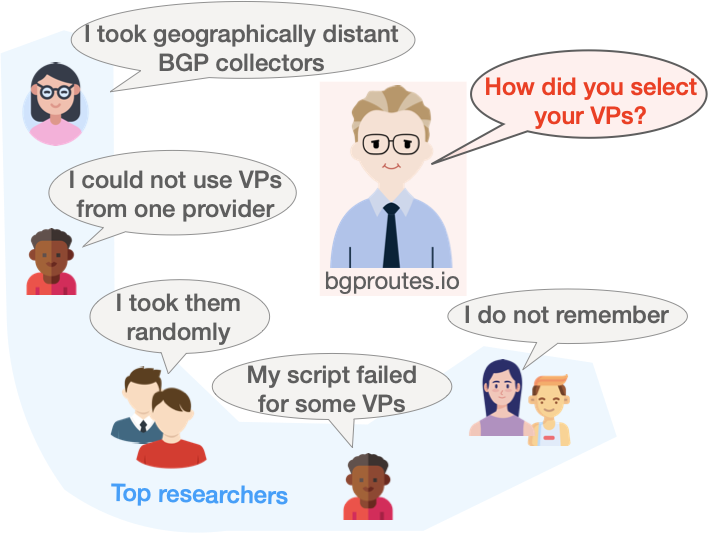BGP extensively propagates reachability messages,
causing BGP Vantage Points (VPs) to observe highly redundant route updates,
which provide low value but increase processing requirements.
MVP is tool that computes redundancy between VPs and advises
users on which VPs to use to maximize the value of collected BGP route updates
while staying within their processing budget.
MVP uses data-driven algorithms designed to compute redundancy
without optimizing for a specific objective.
Therefore, MVP is beneficial for users regardless of how they intend to use the data.
Watch our RIPE 85 presentation
or read our technical report.
It takes as input a year and a volume of data and gives a set of VPs that generates an expected volume of data lower than the volume specified as input. Get Your MVPs!
Why using MVP
We show on the right the collected answers for the question "How did you select your VPs ?". We find that users often select VPs using naive strategies.

Each cell indicates redundancy between the VPs on the x and y-axis. A blue cell means the two VPs tend to observe route updates for the same prefix at the same time. A green cell signifies that the two VPs are not redundant. You can hover your mouse over a cell to identify the VPs and view their redundancy score.
Since many cells are blue, we conclude that a significant number of the selected VPs are redundant.
What you can expect from MVP
If you cannot or do not want to process all the data from RIS and RouteViews, then selecting the VPs from which to process the data using MVP will significantly improve the performance and accuracy of your tool and studies.
| Use Case | Data Reduction Factor
We define the reduction factor to capture how much MVP reduces the number of BGP
updates required to fulfill a particular objective.
A reduction factor of 2 means that we can fulfill a given objective with half as many updates when using MVP compared to when using a baseline. Here, the baseline is a random selection of the VPs. |
|---|---|
| Transient Path Detection
Transient paths are BGP routes
visible for less than five minutes, a typical BGP convergence
delay, and which can be attributed to e.g., path exploration.
We focus on 20000 transient path events randomly selected. |
1.55
This means that with MVP, we can detect 50% of the transit path events with
1.55 times fewer updates compared to when randomly selecting the VPs.
|
| MAOS Hijack Detection
MOAS prefixes are announced
by multiple distinct ASes, which can be caused by legitimate or malicious actions
We focus on 20000 randomly selected MOAS events. |
2.35
This means that with MVP, we can detect 50% of the MOAS events with
2.35 times fewer updates compared to when randomly selecting the VPs.
|
| AS Topology Mapping
This is useful for e.g., inferring
BGP policies or AS paths.
For each VP, we process the first RIB dump of May 2023 as well as the updates collected during the 100 one-hour periods and focus on all distinct AS links observed. |
2.59
This means that with MVP, we can map 50% of the known AS links with
2.59 times fewer updates compared to when randomly selecting the VPs.
|
| Traffic Engineering Detection
We focus on updates for which a path change coincides with the appearance
of an action community. Action communities are associated with traffic engineering actions.
We focus on 8000 path changes.
|
4.59
This means that with MVP, we can detect 50% of the path change events with
4.59 times fewer updates compared to when randomly selecting the VPs.
|
| Unnecessary Updates Detection
An unnecessary update is a BGP update
that only signals a change in the community values but not in the AS path.
We consider 20000 unnecessary updates.
|
1.72
This means that with MVP, we can detect 50% of the unnecessary updates with
1.72 times fewer updates compared to when randomly selecting the VPs.
|
We benchmarked MVP on five use cases and found that it outperforms current
VPs selection strategies.
The table on the right shows the data reduction factor,
a metric that indicates the gain it terms of number of update the process when using MVP.
With MVP, we can achieve a use case while processing between
1.55 and 4.59 fewer updates compared to when selection VPs randomly.
You can move your mouse on the table to find further information.